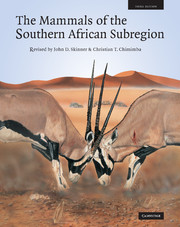Book contents
- Frontmatter
- Contents
- Editorial board
- Acknowledgements
- Foreword
- Preface
- The Mammal Research Institute
- R. H. N. Smithers
- Explanatory notes
- SUPERCOHORT AFROTHERIA
- Order AFROSORICIDA
- Order MACROSCELIDEA
- Order TUBULIDENTATA
- COHORT PAENUNGULATA
- SUPERCOHORT EUARCHONTAGLIRES COHORT GLIRES
- COHORT EUARCHONTA
- SUPERCOHORT LAURASIATHERIA
- COHORT FERUNGULATA
- Bibliography
- Appendix 1 Conservation status of southern African mammals
- Appendix 2 Colloquial names
- Index of scientific names
- Index of English colloquial names
- List of subscribers
- Plate Section
- Plate Section
- Plate Section
- Plate Section
- Plate Section
- Plate Section
- Plate Section
Order MACROSCELIDEA
from SUPERCOHORT AFROTHERIA
Published online by Cambridge University Press: 05 July 2013
- Frontmatter
- Contents
- Editorial board
- Acknowledgements
- Foreword
- Preface
- The Mammal Research Institute
- R. H. N. Smithers
- Explanatory notes
- SUPERCOHORT AFROTHERIA
- Order AFROSORICIDA
- Order MACROSCELIDEA
- Order TUBULIDENTATA
- COHORT PAENUNGULATA
- SUPERCOHORT EUARCHONTAGLIRES COHORT GLIRES
- COHORT EUARCHONTA
- SUPERCOHORT LAURASIATHERIA
- COHORT FERUNGULATA
- Bibliography
- Appendix 1 Conservation status of southern African mammals
- Appendix 2 Colloquial names
- Index of scientific names
- Index of English colloquial names
- List of subscribers
- Plate Section
- Plate Section
- Plate Section
- Plate Section
- Plate Section
- Plate Section
- Plate Section
Summary
THE ELEPHANT-SHREWS were formerly classified as a family in the Order Insectivora and then in the Order Menotyphla, but are now placed in the separate Order Macroscelidea (Butler, 1956, 1972; Patterson, 1965; Meester et al., 1986; Schlitter, 1993c). Based largely on morphological traits, they were considered to be related to the lagomorphs and rodents (Novacek & Wyss, 1986; Sarich, 1993), but more recent evidence from fossils (Simons et al., 1991) and molecular data (Liu et al., 2001; Helgen, 2003; Nikaido et al., 2003) strongly suggest that they are part of a clade (the Supercohort Afrotheria) that includes the aardvark, tenrecs, golden moles, and the Paenungulata (hyracoids, sirenians and elephants). Further confirmation of this is their large functional caecum (Woodall & Mackie, 1987; Spinks & Perrin, 1995), which supports the contention that they evolved from ancestral herbivores, and aspects of the male reproductive system, such as abdominal testes (Patterson, 1965; Rathbun, 1979; Woodall, 1995a) and a long ventral penis (Woodall, 1995b). Because they are not closely related to the true shrews (Family Soricidae in the Order Eulipotyphla), many authors have adopted the use of the common name ‘sengi’ for elephant-shrews (e.g. Kingdon, 1997; Jennings & Rathbun, 2001; Rathbun & Woodall, 2002).
The Macroscelididae is a small family comprising four genera and 15 species (Schlitter, 1993c) whose members occur only on the African continent. Their fossil record, also restricted to Africa, dates back to the Eocene (Butler, 1995).
- Type
- Chapter
- Information
- The Mammals of the Southern African Sub-region , pp. 22 - 34Publisher: Cambridge University PressPrint publication year: 2005
- 3
- Cited by

